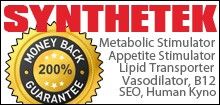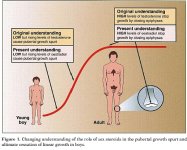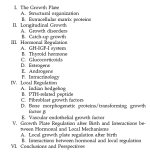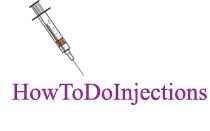- Joined
- Jul 25, 2008
- Messages
- 1,700
Underscoring the importance of 3 hour GH pulsation
The following snippet (from Merck Research Laboratories) & referenced study are fascinating because it is just one more piece of evidence that points to how exogenous Growth Hormone should be administered so as to adapt it to the 3 hour pulsation of natural GH release.
It is ridiculous (in my opinion) to try to make the GHRHs & GHRPs release Growth Hormone in conformance to the way exogenous GH is currently administered (i.e. in non-pulsatile chronically elevated fashion) and/or condemn them for failing to do so.
It is exogenous Growth Hormone that needs to be made to conform to the pattern induced by GHRHs & GHRPs.
MY NOTE: The full study was not available.
The following snippet (from Merck Research Laboratories) & referenced study are fascinating because it is just one more piece of evidence that points to how exogenous Growth Hormone should be administered so as to adapt it to the 3 hour pulsation of natural GH release.
It is ridiculous (in my opinion) to try to make the GHRHs & GHRPs release Growth Hormone in conformance to the way exogenous GH is currently administered (i.e. in non-pulsatile chronically elevated fashion) and/or condemn them for failing to do so.
It is exogenous Growth Hormone that needs to be made to conform to the pattern induced by GHRHs & GHRPs.
Published in Endocrine Reviews 1997, 18 (5): 621-645
Peptidomimetic Regulation of Growth Hormone Secretion
Roy G. Smith, Lex H. T. Van der Ploeg, Andrew D. Howard, Scott D. Feighner, Kang Cheng, Gerard J. Hickey, Matthew J. Wyvratt, Jr., Mike H. Fisher, Ravi P. Nargund and Arthur A. Patchett
Merck Research Laboratories, Rahway, New Jersey 07065
GH secretion is markedly pulsatile in all species studied (140, 141, 142, 143, 144). The biological significance of episodic secretion has been illustrated in GH-deficient animals in which GH replacement is more efficient in improving growth when given in a pulsatile pattern rather than by constant infusion (145). Before describing how we believe the peptidomimetic GH secretagogues themselves are involved in regulating pulsatility, we should first review what is currently understood about the control of pulsatile GH release.
The experimental evidence points to GH periodicity being self-entraining. For example, when GH is given exogenously at intervals of 3 h, approximately in phase with endogenous GH pulses, the exogenous and endogenous GH peaks become entrained (146). If the exogenous pulses are repeated more frequently (every 90 min), the regular endogenous pulsatility disappears (146). Entrainment of the 3-h pulses can be accomplished also by administering a GHRH analog (147) or L-692,585 instead of GH at 3-h intervals (7, 87)
Peptidomimetic Regulation of Growth Hormone Secretion
Roy G. Smith, Lex H. T. Van der Ploeg, Andrew D. Howard, Scott D. Feighner, Kang Cheng, Gerard J. Hickey, Matthew J. Wyvratt, Jr., Mike H. Fisher, Ravi P. Nargund and Arthur A. Patchett
Merck Research Laboratories, Rahway, New Jersey 07065
GH secretion is markedly pulsatile in all species studied (140, 141, 142, 143, 144). The biological significance of episodic secretion has been illustrated in GH-deficient animals in which GH replacement is more efficient in improving growth when given in a pulsatile pattern rather than by constant infusion (145). Before describing how we believe the peptidomimetic GH secretagogues themselves are involved in regulating pulsatility, we should first review what is currently understood about the control of pulsatile GH release.
The experimental evidence points to GH periodicity being self-entraining. For example, when GH is given exogenously at intervals of 3 h, approximately in phase with endogenous GH pulses, the exogenous and endogenous GH peaks become entrained (146). If the exogenous pulses are repeated more frequently (every 90 min), the regular endogenous pulsatility disappears (146). Entrainment of the 3-h pulses can be accomplished also by administering a GHRH analog (147) or L-692,585 instead of GH at 3-h intervals (7, 87)
References:
7 - Fairhall KM, Mynett A, Thomas GB, Robinson ICAF 1996 Central and peripheral effects of peptide and nonpeptide GH secretagogues of GH release in vivo. In: Bercu BB, Walker RF (eds) Growth Hormone Secretagogues. Springer-Verlag, New York, pp 219–236
87 - Fairhall KM, Mynett A, Smith RG, Robinson ICAF 1995 Consistent GH responses to repeated injections of GH-releasing hexapeptide (GHRP-6) and the nonpeptide GH secretagogue, L-692,585. J Endocrinol 145:417–426
140 - Jansson JO, Eden S, Isaksson O 1985 Sexual dimorphism in the control of growth hormone secretion. Endocr Rev 6:128–150
141 - Davis SL, Ohlson DL, Klindt J, Anfinson MS 1977 Episodic growth hormone secretory patterns in sheep: relationship to gonadal steroid hormones. Am J Physiol 233:E519
142 - Steiner RA, Stewart JK, Barber J, Koerker D, Gooner CJ, Brown A, Illner P, Gale CC 1978 Somatostatin: a physiological role in the regulation of growth hormone secretion in the adolescent male baboon. Endocrinology 102:1587
143 - Miller JD, Tannenbaum GS, Colle E, Guyda HJ 1982 Daytime pulsatile growth hormone secretion during childhood and adolescence. J Clin Endocrinol Metab 55:989
144 - Chihara K, Minamitani N, Kaji H, Kodama H, Kita T, Fujita T 1983 Human pancreatic growth hormone-releasing factor stimulates release of growth hormone in conscious unrestrained male rabbits. Endocrinology 113:2081
145 - Gevers EF, Wit JM, Robinson ICAF 1996 Growth, growth hormone (GH)-binding protein, and GH receptors are differentially regulated by peak and trough components of the GH secretory pattern in the rat. Endocrinology 137:1013–1018
146 - See Carlsson below
147 - Clark RG, Robinson ICAF 1985 Growth hormone (GH) responses to multiple injections of a fragment of human GH-releasing factor in conscious male and female rats. J Endocrinol 106:281–289
7 - Fairhall KM, Mynett A, Thomas GB, Robinson ICAF 1996 Central and peripheral effects of peptide and nonpeptide GH secretagogues of GH release in vivo. In: Bercu BB, Walker RF (eds) Growth Hormone Secretagogues. Springer-Verlag, New York, pp 219–236
87 - Fairhall KM, Mynett A, Smith RG, Robinson ICAF 1995 Consistent GH responses to repeated injections of GH-releasing hexapeptide (GHRP-6) and the nonpeptide GH secretagogue, L-692,585. J Endocrinol 145:417–426
140 - Jansson JO, Eden S, Isaksson O 1985 Sexual dimorphism in the control of growth hormone secretion. Endocr Rev 6:128–150
141 - Davis SL, Ohlson DL, Klindt J, Anfinson MS 1977 Episodic growth hormone secretory patterns in sheep: relationship to gonadal steroid hormones. Am J Physiol 233:E519
142 - Steiner RA, Stewart JK, Barber J, Koerker D, Gooner CJ, Brown A, Illner P, Gale CC 1978 Somatostatin: a physiological role in the regulation of growth hormone secretion in the adolescent male baboon. Endocrinology 102:1587
143 - Miller JD, Tannenbaum GS, Colle E, Guyda HJ 1982 Daytime pulsatile growth hormone secretion during childhood and adolescence. J Clin Endocrinol Metab 55:989
144 - Chihara K, Minamitani N, Kaji H, Kodama H, Kita T, Fujita T 1983 Human pancreatic growth hormone-releasing factor stimulates release of growth hormone in conscious unrestrained male rabbits. Endocrinology 113:2081
145 - Gevers EF, Wit JM, Robinson ICAF 1996 Growth, growth hormone (GH)-binding protein, and GH receptors are differentially regulated by peak and trough components of the GH secretory pattern in the rat. Endocrinology 137:1013–1018
146 - See Carlsson below
147 - Clark RG, Robinson ICAF 1985 Growth hormone (GH) responses to multiple injections of a fragment of human GH-releasing factor in conscious male and female rats. J Endocrinol 106:281–289
MY NOTE: The full study was not available.
Endogenous growth hormone (GH) secretion in male rats is synchronized to pulsatile GH infusions given at 3-hour intervals, Carlsson LMS, Jansson JO, Endocrinology 1990 126:6–10
ABSTRACT:
The feedback effects of GH on its own secretion were studied in conscious male rats receiving intermittent iv infusions of human GH. Male Sprague-Dawley rats (150-180 g) were implanted with double bore iv cannula. Infusions of human GH (hGH) or buffer were given for up to 32 h, while frequent microsamples (20 microliters) of blood were withdrawn simultaneously using an automatic blood-sampling system.
The endogenous GH pulses became synchronized to pulsatile hGH infusions (2.1 U/kg.infusion) given at 3-h intervals. After two or more hGH infusions episodic GH release was present in most rats, and all endogenous pulses occurred concomitantly with the hGH infusions. After 24 h of hGH treatment the endogenous pulses were still synchronized to the every 3 h hGH infusions. In addition, the pulse amplitude was lower than that in vehicle-treated animals (74 +/- 12 vs. 215 +/- 35 ng/ml; P less than 0.01).
At this time a complete (1.5-h) phase shift of the 3-hourly hGH infusions markedly suppressed endogenous GH pulses in all rats. In another experiment where the same daily dose of hGH was given in iv infusions every 1.5 h instead of every 3 h, the endogenous GH pulses were irregular, infrequent, and suppressed. Infusions at 3-h intervals of a lower dose of hGH (0.42 U/kg.infusion) did not affect the timing or amplitude of endogenous GH pulses compared to those in buffer-infused animals. The endogenous GH pulses were not synchronized between animals given 0.42 U/kg hGH or buffer at 3-h intervals.
It is concluded that the endogenous GH pulses in male rats became synchronized to intermittent infusions of hGH at 3-h (but not 1.5-h) intervals. The fact that there were no endogenous pulses between the 3-hourly infusions suggests that the feedback effect of a GH pulse lasts for approximately 3 h. This mechanism may be involved in the control of the GH secretory pattern in male rats.
ABSTRACT:
The feedback effects of GH on its own secretion were studied in conscious male rats receiving intermittent iv infusions of human GH. Male Sprague-Dawley rats (150-180 g) were implanted with double bore iv cannula. Infusions of human GH (hGH) or buffer were given for up to 32 h, while frequent microsamples (20 microliters) of blood were withdrawn simultaneously using an automatic blood-sampling system.
The endogenous GH pulses became synchronized to pulsatile hGH infusions (2.1 U/kg.infusion) given at 3-h intervals. After two or more hGH infusions episodic GH release was present in most rats, and all endogenous pulses occurred concomitantly with the hGH infusions. After 24 h of hGH treatment the endogenous pulses were still synchronized to the every 3 h hGH infusions. In addition, the pulse amplitude was lower than that in vehicle-treated animals (74 +/- 12 vs. 215 +/- 35 ng/ml; P less than 0.01).
At this time a complete (1.5-h) phase shift of the 3-hourly hGH infusions markedly suppressed endogenous GH pulses in all rats. In another experiment where the same daily dose of hGH was given in iv infusions every 1.5 h instead of every 3 h, the endogenous GH pulses were irregular, infrequent, and suppressed. Infusions at 3-h intervals of a lower dose of hGH (0.42 U/kg.infusion) did not affect the timing or amplitude of endogenous GH pulses compared to those in buffer-infused animals. The endogenous GH pulses were not synchronized between animals given 0.42 U/kg hGH or buffer at 3-h intervals.
It is concluded that the endogenous GH pulses in male rats became synchronized to intermittent infusions of hGH at 3-h (but not 1.5-h) intervals. The fact that there were no endogenous pulses between the 3-hourly infusions suggests that the feedback effect of a GH pulse lasts for approximately 3 h. This mechanism may be involved in the control of the GH secretory pattern in male rats.



















































































